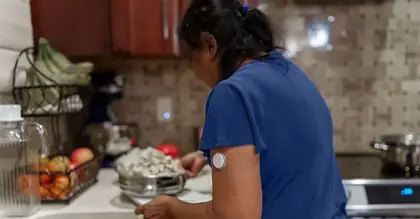Drug Detail:Fluocinonide (Fluocinonide topical [ floo-oh-sin-oh-nide ])
Drug Class: Topical steroids
Usual Adult Dose for Dermatitis
0.05% cream, gel, ointment: Apply a thin layer to affected area two to four times a day
0.1% cream: Apply a thin layer to affected area once or twice a day
Comments:
- Occlusive dressings may be used; however, if an infection develops, the use of occlusive dressings should be discontinued and appropriate antimicrobial therapy initiated.
- Treatment should be limited to 2 consecutive weeks and no more than 60 g per week should be used.
Uses: Relief of the inflammatory and pruritic manifestations of corticosteroid responsive dermatoses
Usual Adult Dose for Eczema
0.05% cream, gel, ointment: Apply a thin layer to affected area two to four times a day
0.1% cream: Apply a thin layer to affected area once or twice a day
Comments:
- Occlusive dressings may be used; however, if an infection develops, the use of occlusive dressings should be discontinued and appropriate antimicrobial therapy initiated.
- Treatment should be limited to 2 consecutive weeks and no more than 60 g per week should be used.
Uses: Relief of the inflammatory and pruritic manifestations of corticosteroid responsive dermatoses
Usual Adult Dose for Atopic Dermatitis
0.1% cream: Apply a thin layer to affected area once a day
Comments:
- Occlusive dressings may be used; however, if an infection develops, the use of occlusive dressings should be discontinued and appropriate antimicrobial therapy initiated.
- Treatment should be limited to 2 consecutive weeks and no more than 60 g per week should be used.
Use: Relief of the inflammatory and pruritic manifestations of atopic dermatitis
Usual Adult Dose for Psoriasis
0.1% cream: Apply a thin layer to affected area once or twice a day
Comments:
- Occlusive dressings may be used; however, if an infection develops, the use of occlusive dressings should be discontinued and appropriate antimicrobial therapy initiated.
- Treatment should be limited to 2 consecutive weeks and no more than 60 g per week should be used.
Use: Relief of the inflammatory and pruritic manifestations of psoriasis
Usual Pediatric Dose for Dermatitis
12 years or older:
0.05% cream, gel, ointment: Apply a thin layer to affected area two to four times a day
0.1% cream: Apply a thin layer to affected area once or twice a day
Comments:
- Occlusive dressings may be used; however, if an infection develops, the use of occlusive dressings should be discontinued and appropriate antimicrobial therapy initiated.
- Treatment should be limited to 2 consecutive weeks and no more than 60 g per week should be used.
Uses: Relief of the inflammatory and pruritic manifestations of corticosteroid responsive dermatoses
Usual Pediatric Dose for Eczema
12 years or older:
0.05% cream, gel, ointment: Apply a thin layer to affected area two to four times a day
0.1% cream: Apply a thin layer to affected area once or twice a day
Comments:
- Occlusive dressings may be used; however, if an infection develops, the use of occlusive dressings should be discontinued and appropriate antimicrobial therapy initiated.
- Treatment should be limited to 2 consecutive weeks and no more than 60 g per week should be used.
Uses: Relief of the inflammatory and pruritic manifestations of corticosteroid responsive dermatoses
Usual Pediatric Dose for Psoriasis
12 years or older:
0.1% cream: Apply a thin layer to affected area once or twice a day
Comments:
- Occlusive dressings may be used; however, if an infection develops, the use of occlusive dressings should be discontinued and appropriate antimicrobial therapy initiated.
- Treatment should be limited to 2 consecutive weeks and no more than 60 g per week should be used.
Use: Relief of the inflammatory and pruritic manifestations of psoriasis
Usual Pediatric Dose for Atopic Dermatitis
12 years or older:
0.1% cream: Apply a thin layer to affected area once a day
Comments:
- Occlusive dressings may be used; however, if an infection develops, the use of occlusive dressings should be discontinued and appropriate antimicrobial therapy initiated.
- Treatment should be limited to 2 consecutive weeks and no more than 60 g per week should be used.
Use: Relief of the inflammatory and pruritic manifestations of atopic dermatitis
Renal Dose Adjustments
Data not available
Liver Dose Adjustments
Data not available
Precautions
Safety and efficacy have not been established in patients younger than 12 years.
Consult WARNINGS section for additional precautions.
Dialysis
Data not available
Other Comments
Administration advice:
- This drug should not be used on the face, groin, or axillae.
- The treated area should not be bandaged, covered, or wrapped, as to be occlusive, unless directed by a healthcare provider.
- Parents of pediatric patients should be advised not to use tight-fitting diapers or plastic pants on a child being treated in the diaper area.
Storage requirements:
- Excessive heat should be avoided.
General:
- This drug should not be used in the treatment of rosacea or perioral dermatitis.
Monitoring:
- Endocrine: HPA-axis suppression (Urinary free-cortisol test, ACTH-stimulation test)
Patient advice:
- Patients should report any signs of local adverse reactions, especially those that develop under occlusive dressings.
Frequently asked questions
- Is it used for hair loss?
- What is a substitute for fluocinonide cream?
- What causes Plaque Psoriasis?
- Is fluocinonide safe to use on your face?
- Is fluocinonide an antifungal cream?
- How long should you use fluocinonide for?
- What is fluocinonide cream good for?
- Is it a steroid?
- Can fluocinonide be used to treat a poison ivy rash?
- Is this an antibiotic?




